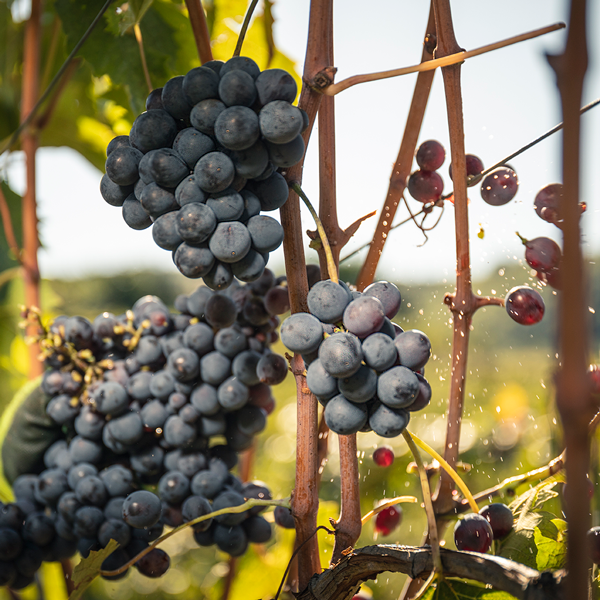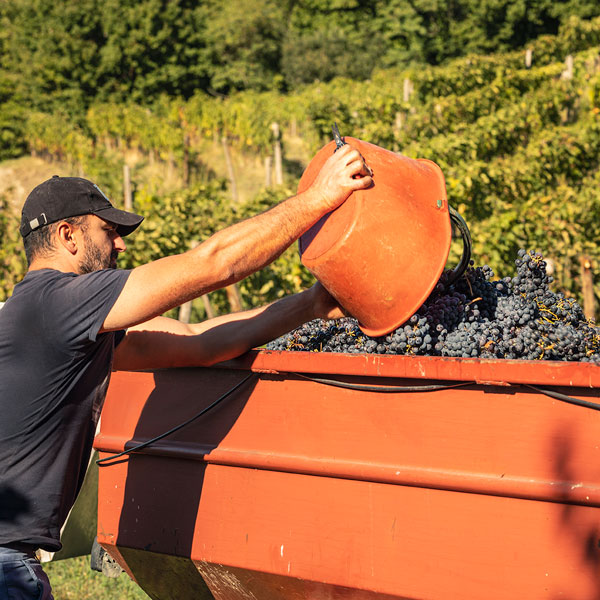Italy had to struggle with extreme weather events in 2021: late frost, hail and temperatures above 40 °C led to nine percent less harvest than in the previous year. Tuscany was particularly hard hit, with a 25 percent loss, and Chianti in particular, with up to 35 percent. Prices will rise significantly there, Raffaella Usai has researched.
According to the International Organisation of Vine and Wine (OIV), Italy produced more wine in 2021 than all other countries and, with an estimated 44.5 million hectolitres, is quite a bit ahead of Spain (35 million hl) and France (34.2 million hl). However, in Italy, too, less wine flowed into the cellars than in 2020. Especially in Tuscany, Lombardy, Emilia Romagna and Abruzzo, the winegrowers complain of high losses. Only Campania, Calabria and Sicily recorded a slight increase, see table.

The reason for the crop failures was the unfavourable weather, starting with late frost in April. This resulted in poor fruit set and damaged early sprouting varieties and young plants in particular. As reported bywein.plus , the vines in Piedmont, Veneto and Tuscany were particularly affected. In July, the north-east of Italy was hit by severe storms, heavy hailstorms destroyed part of the harvest. And the high and long-lasting August temperatures of up to over 40 °C, combined with drought stress, led to noticeable losses in volume.
Riccardo Cotarella, president of the Italian oenologists' association Assoenologi, confirms that the extreme weather caprices demand everything from the winegrowers and keep them on constant alert: "Climate change is having an ever greater impact on agriculture and thus also on viticulture. We have to apply the latest scientific knowledge with extreme care if we want to harvest good to very good quality."
Tuscany may not be one of Italy's most important regions in terms of volume, but it is one of the flagships of Italian viticulture. Around 25 per cent less volume was harvested here in 2021. The biggest losses were in Maremma, Chianti and the Vino Nobile di Montepulciano appellation. The declines in Chianti Classico and Brunello di Montalcino, on the other hand, were limited. Francesco Colpizzi, president of the Confagricoltura Toscana association, considers a price increase unavoidable: "The low harvest volumes and the explosive increase in raw material prices will result in an increase in bottle prices of at least ten percent."
The Chianti consortium is pushing to bring forward the launch of the 2021 vintage by two months, contrary to production rules. It says this is a necessary step to avoid a shortage of products for sale in view of the drop in production. The consortium speaks of a harvest loss of between 30 and 35 per cent. The cellars are empty. "Prices have already risen by 25 percent," explains the director of the Chianti consortium Marco Alessandro Bani, and demand continues to rise. "We must not risk Chianti disappearing from wholesale shelves in favour of other, cheaper wines. It would take years to get listed again. We would have to accept an extreme drop in prices."
Laila van Fraeijenhove is export manager of wineries in Emilia Romagna, Umbria and Tuscany. All the wineries she looks after have had significant harvest losses, especially white grape varieties are affected. In Romagna, they are talking about a total of about 30 percent less yield than in 2020, in Umbria 20 percent less was harvested and in San Gimignano in Tuscany even 35 percent.
Despite lower volumes, van Fraeijenhove has little concern that her clients' wines will be discontinued: "My experience shows that specialist retailers prefer to work with consolidated brands rather than take on new businesses. We will have to raise prices by 15 per cent in the coming year. Loyal customers understand this, most of my importers have reckoned with it. For the wineries that have only recently started to explore new markets abroad, the price increases are a problem. Finding new customers will be difficult for them in 2022."
After Tuscany, Lombardy has suffered the highest losses. In Valtellina, winemakers have harvested between 20 and 30 per cent fewer Nebbiolo grapes. Pierpaolo di Franco from the Dirupi winery speaks of a climatically very untypical vintage with persistent drought in spring and an unusually rainy summer. "After we lost half of the grapes in 2020 and the quality was also only mediocre, we are very satisfied with this year's harvest. The 2021 wines in the cellar are promising. Maybe the tannins are less elegant than usual, but we really like the flavours."
How do smaller wineries cope with two lean vintages in a row? Pierpaolo di Franco: "Due to the pandemic, demand from abroad decreased - and that actually suited us at first. The Italian market recovered relatively quickly, the restaurants ordered. At the moment, almost everything is staying in Italy. Of course, there is a risk that importers will look for other wineries if we can't deliver the desired quantities."

Massimo Ronca from the Ronca winery in Bardolino on Lake Garda is even complaining about a 40 per cent crop shortfall. For him, it was mainly the red grapes that were affected: Corvina, Rondinella and Merlot. Ronca nevertheless gets the amount he needs for his bottle production, because he normally does not market his entire harvest himself, but sells part of it to wineries. "Before the harvest, I got many desperate calls from colleagues looking for grapes. Prices for grapes and bulk wine have gone up by at least ten percent in our area."
Of greater concern to Massimo Ronca than the poor harvest are the increased prices for packaging, bottles and labels and the threat of supply shortages. "My suppliers have announced further price increases for 1 January, so I had to place my orders already in November. Still, no supplier can promise that my goods will be delivered before the scheduled bottling in February," says Ronca. " I know some winemakers who deliver their bottles in big crates to the restaurants because they have no more boxes."
Bad news for Lambrusco fans, too. Among the most affected grape varieties in Emilia is Lambrusco Grasparossa, which is grown in the hills around Castelvetro. But there were also 20 to 25 percent fewer of the Lambrusco varieties Salamino and Sorbara from the plains. "The production slump", explains Marcello Bonvicini, president of the farmers' association of the Emilia Romagna region, Confagricoltura, "will be accompanied by an imbalance on the market. We expect demand to increase and prices to rise. Abroad, we have to do aggressive marketing to gain market share - especially in France, where the harvest has been even worse than ours."
Among the few winners in 2021 are Sicilian wineries, which harvested almost ten per cent more. Antonio Rallo, president of the Consorzio di Tutela Vini Doc Sicilia, speaks of "perfect conditions for healthy grapes". The rainfall on the island was mainly concentrated in winter, while spring and summer were dry. They are also pleased about positive export figures, especially for white wines, which even recorded an increase of 25 percent in the first nine months of the year compared to 2020.
Region |
2020 |
2021 |
Difference in % |
| Piedmont | 2,703 | 2,433 | -10% |
| Valle d'Aosta | 19 | 18 | -7% |
| Lombardy | 1,541 | 1,233 | -20% |
| Trentino-Alto Adige | 1,294 | 1,168 | -10% |
| Veneto | 11,717 | 10,838 | -7% |
| Friuli Jul. Veneto | 1,853 | 1,723 | -7% |
| Liguria | 40 | 36 | -10% |
| Emilia Romagna | 7,890 | 6,707 | -15% |
| Tuscany | 2,209 | 1,650 | -25% |
| Umbria | 378 | 312 | -18% |
| Marche | 889 | 778 | -13% |
| Lazio | 784 | 706 | -10% |
| Abruzzo | 3,494 | 2,883 | -18% |
| Molise | 235 | 200 | -15% |
| Campania | 715 | 751 | 5% |
| Puglia | 9,000 | 8,550 | -5% |
| Basilicata | 73 | 65 | -10% |
| Calabria | 97 | 106 | 10% |
| Sicily | 3,660 | 3,986 | 9% |
| Sardinia | 475 | 404 | -15% |
| Italy | 49,066 | 44,546 | -9% |
Source: Agea for 2020 and estimates by Assoenologi, Ismea and UIV for 2021.
Photos: © Consorzio Chianti Classico